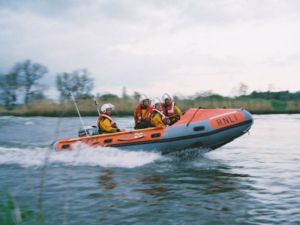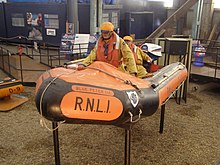D-class lifeboat (EA16): Difference between revisions
| Line 154: | Line 154: | ||
==External links== |
==External links== |
||
[[Image:BluePeterIII-LifeboatD-112.jpg|thumb|right|D-112 ''Blue Peter III'' part of the Royal National Lifeboat Collection on display at the Historic Dockyard, Chatham.]] |
[[Image:BluePeterIII-LifeboatD-112.jpg|thumb|right|D-112 ''Blue Peter III'' part of the Royal National Lifeboat Collection on display at the Historic Dockyard, Chatham.]] |
||
*[http://www.rnli.org.uk/ |
*[http://www.rnli.org.uk/what_we_do/lifeboats/current_lifeboats/fleet RNLI Fleet] |
||
*[http://www.rnli.co.uk/what_we_do/rapid_response_unit RNLI Rapid Response Page] |
*[http://www.rnli.co.uk/what_we_do/rapid_response_unit RNLI Rapid Response Page] |
||
Revision as of 10:04, 23 May 2011

| |
| Class overview | |
|---|---|
| Builders | Avon Inflatables |
| Operators | |
| In service | 1963– |
| General characteristics | |
| Length | 4.9 m (16 ft) |
| Propulsion | 1 × Mariner outboard engine, 40 hp (30 kW) |
| Speed | 20 knots (23 mph; 37 km/h) |
| Endurance | 3 hours at full speed |
| Complement | 3 or 4 |
The D class lifeboat is a class of inflatable boat operated by the Royal National Lifeboat Institution of the United Kingdom and Ireland.
Utilization
For more than 40 years the D-class has served as the workhorse of the RNLI Inshore Lifeboat (ILB) fleet. Significantly smaller in comparison to the rest of the inshore fleet, the D-class is also one of the few RNLI types not to feature a rigid hull. The main aspect of the boat would be both its size and weight - only 436 kg (961 lb). The D-class has been specifically designed as a light and highly manoeuvrable rapid response craft.
Design and construction
The D-class lifeboat consists of two sponsons, together housing seven inflatable segments intersected by baffles. The main construction fabric is Hypalon-coated Nylon which provides a durable, non-tear surface.
This is one of the smaller classes of lifeboat operated by the RNLI, and they are a common sight at lifeboat stations around the coast. Unlike other members of the ILB fleet, the D-class does not have a rigid hull; all others, with the exception of the Arancia, hovercraft and ALB Tenders, are Rigid Inflatable Boats (RIBs).
The D-class normally has a crew of three or four and is primarily used for surfer/swimmer incidents as well as assisting in cliff incidents where the casualty is near the water. The very nature of its work requires a swift response, and the D-class can normally be afloat within five minutes of the pagers going off.
Stations using D class lifeboats
There are currently 81 RNLI stations in the UK and Ireland using D-class lifeboats, with 84 D-class lifeboats operating.
These are: (Station:boat name)
- Aberdeen: James Bissett Simpson
- Aldeburgh: Christine
- Amble: Rosemary Palmer
- Barmouth: Clive Tanner
- Barrow: Spirit of Tamworth
- Blackpool: Norah Cadman, and William & Rose Nall-there are two D-class lifeboats at this station.
- Bridlington: Lord Feoffees III
- Broughty Ferry(Dundee): Sheila Barrie
- Burham-on-Crouch: Ernest and Rose Chapman
- Burry Port: The Young Watsons
- Blyth: Jennie B
- Calshot: 248 Squadron RAF
- Campbelltown: Three Brothers
- Cardigan: Society of Societies
- Clacton-on-Sea: Seahorse II
- Cleethorpes: Blue Peter VI
- Clifden: Grainne Uaile
- Conwy: Arthur Bate II
- Courtown: Star of the Sea
- Craster: Joseph Hughes
- Cromer: Seahorse III
- Dun Laoghaire: Tony Heard
- Dunbar: Jimmy Miff
- Dartmouth: Spirit of the Dart
- Eastbourne: Joan and Ted Wiseman 50
- Exmouth: George Bearman
- Fenit: Cursitor Street
- Fethard: Tradewinds
- Filey: Rotary District 1120
- Fishguard: Team Effort
- Fleetwood: Saddleworth
- Flint: Sir Y Flint
- Fowey: Olive II
- Hastings: Cecile Rampton II
- Hollyhead: Angel of Holyhead
- Horton and Port Eynon: Albert Wordley
- Howth: George Godfrey Benbow
- Ilfracombe: Deborah Brown
- Kippford: David Whitehead
- Larne: Hannabella Ferguson
- Looe: Regina Mary
- Lough Swilly (Buncrana): Minnie and Ernest George Barry
- Mablethorpe: William Hadley
- Margate: Tigger Too
- Minehead: George and Christine
- Moelfre: Enfys
- Morecambe: Peter Bond
- Newcastle: Aldergrove II
- North Berwick: Blue Peter III
- Penarth: Connie Dains
- Port Isaac: Spirit of the RE II
- Port St Mary: Hounslow
- Port Talbot: Gwenllian
- Portrush: Ken & Mary
- Portsmouth: Heyland II
- Pwllheli: leslie and Peter Downes
- Redcar: Jack Hunsley
- Rock: Rusper
- Scarborough: John Wesley Hillard II
- Seahouses: Peter Downes
- Selsay: Peter Cornish
- Sheerness: Eleanor
- Shoreham Harbour: Barry Lazell
- Skegness: Tom Broom
- South Broads: Lawnflite
- Southend-on-Sea: Ethel Royal & pride of London Foresters-there are two D-class lifeboats at this station.
- St Agnes: Blue Peter IV
- St Davids: Murtle and Trevor Gurr
- St Ives: The Colin bramley Parker
- Stranraer: Stranraer Saviour (Civil Service No.49)
- Swanage: Jack Cleare
- Teddington: Spirit of Mortimer & Spirit of the Thames-there are two D-class lifeboats at this station.
- Tenby: Georgina Stanley Taylor
- Torbay: John William Hirst
- Trearddur Bay: Flo and Dick Smith
- Walmer: Duggie Rodbard
- Wells: Jane Ann III
- West Kirby: Dave & Trevor Jones
- Weston-super-Mare: Anna Stock
- Wexford: Philip Booth
- Wicklow: Sheringham Shantymen
- Withernsea: Henley Eight
References
External links

